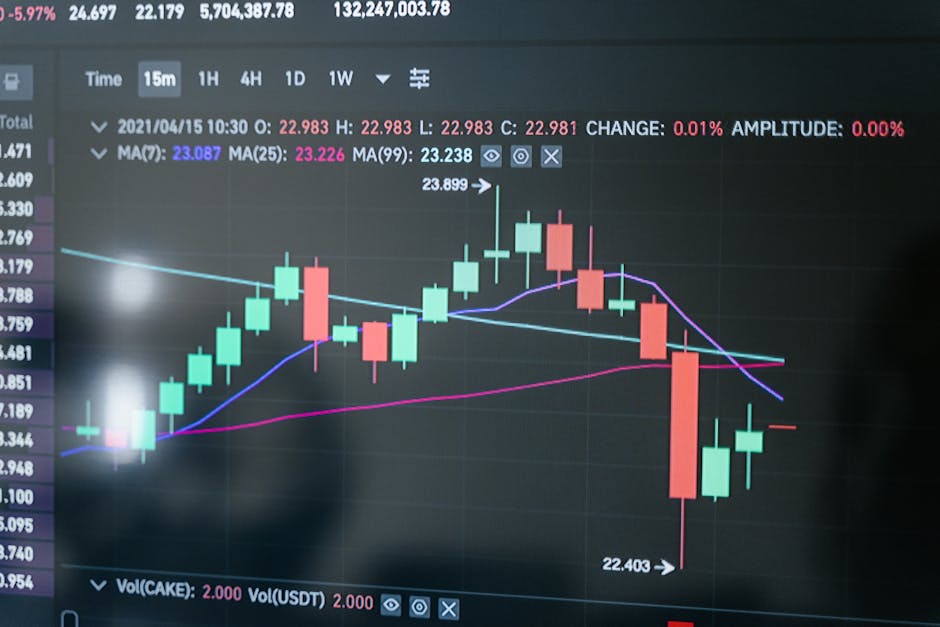Blockchain Technology: Revolutionizing Workplace Management in 2025
“Blockchain technology is reshaping how organizations manage their workplace operations. This article explores how decentralized ledger technology provides unprecedented security, transparency, and efficiency for corporate HR managers, IT departments, facility management teams, and educational institutions, with practical implementation strategies and real-world case studies. ”

Blockchain Technology: Transforming Workplace Management
In today's rapidly evolving digital landscape, organizations are constantly seeking innovative solutions to enhance their operational efficiency, security, and transparency. Blockchain technology, originally developed as the foundation for cryptocurrency transactions, has emerged as a powerful tool with applications far beyond financial services. For workplace management professionals—including corporate HR managers, IT departments, facility management teams, and educational institutions—blockchain offers revolutionary possibilities to transform how we manage workplaces.

Understanding Blockchain in the Workplace Context
What Is Blockchain?
At its core, blockchain is a decentralized, distributed digital ledger that records transactions across many computers. This structure ensures that any recorded data cannot be altered retroactively without changing all subsequent blocks, making it inherently secure and transparent. Unlike traditional centralized databases, blockchain distributes identical copies of the ledger across all participating computers (nodes) in the network.
The key characteristics that make blockchain valuable for workplace management include:
- Immutability: Once data is recorded, it cannot be altered or deleted
- Transparency: All authorized participants have access to the same information
- Security: Cryptographic encryption protects data integrity
- Decentralization: No single point of failure or control
- Smart Contracts: Self-executing contracts with terms directly written into code
Beyond Cryptocurrency: Practical Applications
While blockchain gained fame through Bitcoin, its underlying technology offers much more. In workplace management, blockchain can address critical challenges around data security, process efficiency, and trust between stakeholders. The technology enables secure, transparent record-keeping without requiring intermediaries to verify transactions.
Transforming HR Management with Blockchain
Human Resources departments handle sensitive employee information daily, from personal data to compensation details. Blockchain technology offers several advantages for modernizing HR processes:
Secure Credential Verification
Verifying employment history, educational credentials, and professional certifications traditionally requires time-consuming background checks. With blockchain, these credentials can be securely stored and easily verified without compromising privacy.
For example, when a new employee joins your organization, their credentials can be instantly verified through a blockchain-based system that confirms the authenticity of their qualifications without requiring multiple calls to previous employers or educational institutions.
Streamlined Payroll and Benefits
Blockchain can revolutionize payroll processing, especially for organizations with international workforces. Smart contracts can automate payments based on predefined conditions, ensuring employees receive compensation accurately and on time, regardless of geographic location.

Benefits administration becomes more transparent as well. Employees can have greater visibility into their benefits packages, while HR managers gain more efficient tools for managing enrollment periods and processing claims.
Enhanced Data Privacy and Compliance
With increasing regulations like GDPR and CCPA, data privacy has become a critical concern for HR departments. Blockchain's encryption and permission-based access create a more secure environment for storing sensitive employee information, helping organizations maintain compliance while protecting employee privacy.
IT Management and Blockchain Integration
For IT managers, blockchain presents both implementation challenges and significant opportunities to enhance information security and operational efficiency.
Asset Tracking and Management
IT departments typically manage thousands of assets, from laptops and mobile devices to software licenses. Blockchain provides an immutable record of asset ownership, location, and maintenance history, dramatically improving inventory management and reducing loss.
When an employee receives a new laptop, for instance, the transaction is recorded on the blockchain, creating a permanent, tamper-proof record. As the device moves through its lifecycle—from deployment to maintenance to retirement—each step is documented, creating complete transparency in the asset management process.
Secure Access Management
Controlling access to sensitive systems and data is a fundamental IT responsibility. Blockchain-based identity management systems can provide more secure authentication mechanisms than traditional username/password combinations.
These systems can implement multi-factor authentication while maintaining a comprehensive audit trail of access attempts, helping IT teams identify and respond to potential security breaches more effectively.
Supply Chain Integrity
For organizations that manage complex IT supply chains, blockchain offers unprecedented visibility into the provenance of hardware and software components. This transparency helps prevent counterfeit products from entering your infrastructure and ensures compliance with procurement policies.
Facility Management Applications
Real estate and facility managers face unique challenges in managing physical spaces efficiently. Blockchain technology offers innovative solutions to optimize space utilization, maintenance processes, and visitor management.
Smart Building Management
Smart contracts can automate facility management processes, from temperature control to maintenance scheduling. When sensors detect that a system requires maintenance, a smart contract can automatically generate work orders, schedule technicians, and even process payments upon completion.

This automation reduces administrative overhead and ensures that maintenance issues are addressed promptly, extending the lifespan of building systems and improving occupant comfort.
Space Utilization and Booking
In the era of hybrid work, efficient space optimization has become critical. Blockchain-based systems can provide transparent, tamper-proof records of space utilization, helping facility managers make data-driven decisions about office layouts and capacity planning.
For booking systems, blockchain eliminates double-bookings and provides a clear audit trail of space usage. This transparency is particularly valuable in shared workspaces or educational environments where multiple stakeholders compete for limited resources.
Vendor Management and Compliance
Facility managers typically work with numerous vendors for services ranging from cleaning to security. Blockchain can streamline vendor management by creating immutable records of service agreements, performance metrics, and compliance documentation.
When a vendor completes a service, the transaction is recorded on the blockchain, creating an indisputable record that can be used for billing, performance evaluation, and compliance reporting.
Educational Institution Applications
For school and college IT managers, blockchain offers powerful tools to enhance administrative efficiency, credential verification, and student records management.
Secure Academic Credentials
Academic credential fraud is a growing concern for educational institutions. Blockchain provides a secure, verifiable system for issuing and validating degrees, certificates, and transcripts. Once recorded on the blockchain, these credentials cannot be altered or falsified, maintaining the integrity of the institution's academic standards.
Students benefit from having permanent access to their credentials, which they can share with employers or other institutions without going through cumbersome verification processes.
Streamlined Administrative Processes
Educational institutions manage complex administrative processes, from enrollment to financial aid distribution. Blockchain can automate many of these processes through smart contracts, reducing administrative overhead and improving service to students.
For example, when a student meets all graduation requirements, a smart contract can automatically issue their degree, update their transcript, and notify relevant departments—all without manual intervention.
Enhanced Research Collaboration
For research-focused institutions, blockchain can facilitate secure sharing of research data while maintaining appropriate access controls and attribution. This transparency promotes collaboration while protecting intellectual property and ensuring proper credit for contributions.
Implementation Considerations and Challenges
While blockchain offers significant benefits, implementing this technology requires careful planning and consideration of several factors:
Integration with Existing Systems
Most organizations have substantial investments in legacy systems that cannot be replaced overnight. Successful blockchain implementation typically requires integration with existing infrastructure, which may present technical challenges.
Organizations should start with small pilot projects that demonstrate value without disrupting critical operations. As these pilots prove successful, the blockchain implementation can be gradually expanded.
Regulatory Compliance
Depending on your industry and location, various regulations may impact how you implement blockchain technology. For example, GDPR's "right to be forgotten" presents challenges for blockchain's immutable nature.
Working with legal experts to ensure compliance from the outset is essential. In some cases, this may mean storing certain types of data off-chain while using blockchain for verification purposes.
Energy Consumption
Traditional blockchain implementations, particularly those using proof-of-work consensus mechanisms, have been criticized for their high energy consumption. For organizations with sustainability goals, this concern must be addressed.
Fortunately, newer blockchain technologies use more energy-efficient consensus mechanisms like proof-of-stake, dramatically reducing their environmental impact. When selecting a blockchain platform, energy efficiency should be a key consideration.
Real-World Success Stories
Several organizations have already successfully implemented blockchain in workplace management contexts:
IBM's Blockchain-Based Supplier Management
IBM has implemented a blockchain-based system for managing its global supplier network. This system provides real-time visibility into supplier performance, contract compliance, and payment processing, significantly reducing administrative costs while improving supplier relationships.
Arizona State University's Trusted Credentials
Arizona State University has implemented a blockchain-based system for issuing and verifying academic credentials. This system allows graduates to share their credentials with employers securely, reducing verification time from weeks to seconds while eliminating the possibility of credential fraud.
Maersk's Supply Chain Transparency
Shipping giant Maersk has partnered with IBM to create TradeLens, a blockchain-based platform that provides end-to-end visibility into shipping logistics. This transparency has reduced paperwork, accelerated customs clearance, and improved inventory management for participants throughout the supply chain.
Getting Started with Blockchain in Your Organization
If you're considering implementing blockchain in your workplace management strategy, here are some practical steps to get started:
1. Identify Specific Use Cases
Rather than implementing blockchain for its own sake, identify specific problems in your organization that blockchain could solve. Focus on areas where transparency, immutability, and decentralization would add significant value.
2. Start Small with Pilot Projects
Begin with limited-scope pilot projects that demonstrate value without disrupting critical operations. These pilots should have clear objectives and metrics for success.
3. Build Internal Expertise
Invest in training for your team to build internal blockchain expertise. This knowledge will be invaluable as you expand your blockchain implementation.
4. Choose the Right Platform
Several blockchain platforms are available, each with different strengths and weaknesses. Ethereum is popular for smart contracts, while Hyperledger Fabric is designed specifically for enterprise applications. Evaluate platforms based on your specific requirements.

5. Partner with Experts
Consider partnering with blockchain consultants or technology providers who have experience in your industry. Their expertise can help you avoid common pitfalls and accelerate your implementation.
The Future of Blockchain in Workplace Management
As blockchain technology continues to mature, we can expect several emerging trends to shape its application in workplace management:
Integration with Other Technologies
The combination of blockchain with other emerging technologies like artificial intelligence, Internet of Things, and machine learning will create powerful new capabilities for workplace management. For example, IoT sensors could trigger smart contracts that automatically schedule maintenance based on actual equipment conditions rather than fixed schedules.
Increased Standardization
As blockchain adoption grows, we'll likely see increased standardization of protocols and interfaces, making it easier to implement blockchain solutions across organizational boundaries. These standards will facilitate interoperability between different blockchain platforms and traditional systems.
Regulatory Maturity
Regulatory frameworks for blockchain are still evolving. As these frameworks mature, organizations will have greater clarity about how to implement blockchain solutions while maintaining compliance with relevant regulations.
Conclusion
Blockchain technology offers transformative potential for workplace management across HR, IT, facility management, and educational contexts. By providing unprecedented security, transparency, and efficiency, blockchain can help organizations overcome longstanding challenges in these areas.
While implementation requires careful planning and consideration of various factors, the potential benefits make blockchain a technology that workplace management professionals cannot afford to ignore. By starting with focused pilot projects and building internal expertise, organizations can begin to harness the power of blockchain to transform their workplace management practices.
As we move further into the digital age, blockchain will likely become an essential component of the workplace management toolkit, enabling new levels of efficiency, security, and trust across organizational boundaries.
Additional Resources
For those interested in learning more about blockchain implementation in workplace management, these resources provide valuable insights:
- IBM's Blockchain for Business guide
- Hyperledger Foundation's enterprise blockchain resources
- MIT Sloan Management Review's blockchain research
- Blockchain Research Institute's industry reports
- Gartner's blockchain technology research
By staying informed about blockchain developments and carefully planning your implementation strategy, you can position your organization to take full advantage of this revolutionary technology.